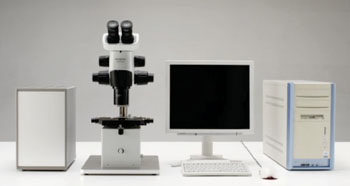Thyroid Lesions Examined by Scanning Acoustic Microscope
By LabMedica International staff writers
Posted on 05 Mar 2014
A scanning acoustic microscope (SAM) uses ultrasound to image an object by plotting the speed-of-sound (SOS) through tissues on screen, and because hard tissues result in great SOS, SAM can provide data on the tissue elasticity.Posted on 05 Mar 2014
Scanning acoustic microscopy uses ultrasound at 120 MHz with almost the same resolution of approximately 12.5 μm as the low magnification of a light microscope (LM), and it had been found useful in generating useful information on the lung, stomach, and lymph node lesions.

Image: The scanning acoustic microscope AMS-50SI system (Photo courtesy of Honda Electronics Co, Ltd).
Scientists at Hamamatsu University School of Medicine (Japan) selected and examined formalin-fixed, paraffin-embedded blocks that were flat-sectioned in 10 μm thick sections from patients with inflammatory non-neoplastic and neoplastic thyroid lesions. Specimens were randomly selected from the computer database of pathological sections and typical lesions of thyroid diseases were identified based on hematoxylin and eosin sections.
The formalin-fixed, paraffin sections were scanned with a 120 MHz transducer using the SAM model AMS-50AI (Honda Electronics Co, Ltd; Toyohashi, Japan). SOS through each area was calculated and plotted on the screen to provide histological images, and SOS of each lesion was compared and statistically analyzed.
High-concentrated colloids, red blood cells, and collagen fibers showed pronounced SOS while low-concentrated colloids, parathyroids, lymph follicles, and epithelial tissues including carcinomas demonstrated lower SOS. SAM clearly discriminated structure of thyroid components corresponding to low magnification of light microscopy. Thyroid tumors were classified into three groups by average SOS: the fast group consisted of follicular adenomas/carcinomas and malignant lymphomas; the slow group contained poorly differentiated/undifferentiated carcinomas; and the intermediate group comprised papillary/medullary carcinomas.
The authors concluded that SAM imaging has the following benefits: precise images were acquired in a few minutes without special staining; structural irregularity and desmoplastic reactions, which indicated malignancy, were detected; images reflected tissue elasticity, which was statistically comparable among lesions by SOS; and tumor classification was predictable by SOS because more poorly differentiated carcinomas had a tendency to show lower SOS. The study was published on February 11, 2014, in the journal Pathology and Laboratory Medicine International.
Related Links:
Hamamatsu University School of Medicine
Honda Electronics Co, Ltd












.jpg)
